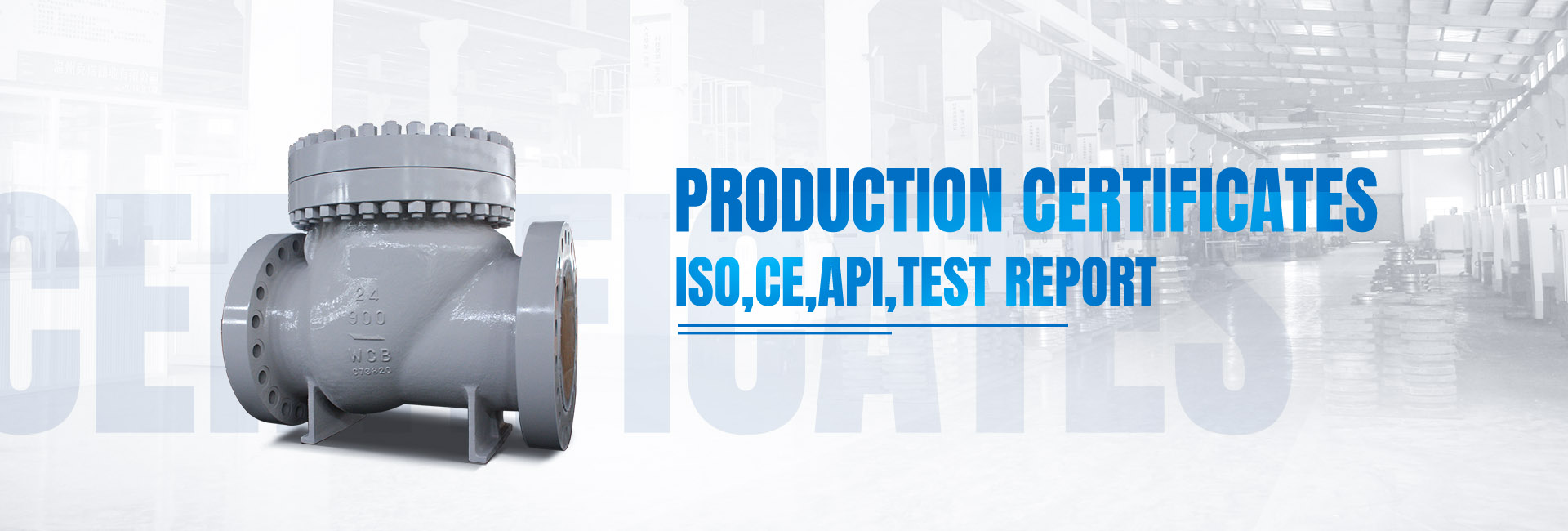1. Valve disintegration
1.1 Remove the fixing bolts of the upper frame of the bonnet, unscrew the nuts of the four bolts on the lifting bonnet, turn the valve stem nut counterclockwise to make the valve frame separate from the valve body, and then use a lifting tool to hoist the frame down and put it down. to the appropriate location. The stem nut part is to be disassembled for inspection.
1.2 Take out the retaining ring at the sealing ring of the valve body, and press down the bonnet with a special tool to create a gap between the valve cover and the ring. Then take out the quadruple ring in sections. Finally, lift the valve cover together with the valve stem and valve disc out of the valve body with a lifting tool. On the maintenance site, pay attention to prevent damage to the valve disc joint surface.
1.3 Clean the inside of the valve body, check the condition of the valve seat joint surface, and determine the maintenance method. Cover the disassembled valve with a special cover or cover, and stick a seal.
1.4 Loosen the hinge bolts of the stuffing box on the bonnet. The packing gland is loosened and the valve stem is unscrewed.
1.5 Disassemble the upper and lower splints of the disc frame, take out the left and right discs, and keep their internal universal tops and gaskets. Measure the total gasket thickness and record it.
2 Repair of various parts of the API Gate valve:
2.1 The joint surface of the gate valve seat should be ground with a special grinding tool (grinding gun, etc.). Grinding can use abrasive sand or emery cloth. The method is also from coarse to fine, and finally polished.
2.2 The joint surface of the valve disc can be ground by hand or grinding machine. If there are deep pits or grooves on the surface, it can be sent to a lathe or grinder for micro-processing, and it can be polished after leveling.
2.3 Clean the valve cover and sealing packing, remove the rust on the inner and outer walls of the packing pressure ring, so that the pressure ring can be smoothly inserted into the upper part of the valve cover, which is convenient for pressing the sealing packing.
2.4 Clean the packing inside the valve stem stuffing box, check whether the inner packing seat ring is in good condition, the gap between the inner hole and the cutting rod should meet the requirements, and there should be no jamming between the outer ring and the inner wall of the stuffing box.
2.5 Clean the rust on the packing gland and the pressure plate, and the surface should be clean and intact. The gap between the inner hole of the gland and the cutting rod should meet the requirements, and the outer wall and the filler should meet the requirements.
The material box should be free of jams, otherwise it should be repaired.
2.6 Loosen the hinge bolt. Check that the thread part should be intact and the nut should be intact. It can be lightly screwed to the root of the bolt by hand, and the pin should be flexibly rotated.
2.7 Clean the rust on the surface of the valve stem, check whether it is bent or not, and straighten it if necessary. The trapezoidal thread part should be intact, without breakage and damage, and be coated with lead powder after cleaning.
2.8 Clean the quadruple ring, the surface should be smooth. Flat surfaces must not have burrs or curls.
2.9 All fastening bolts should be cleaned, the nut should be complete and flexible, and the thread part should be coated with lead powder.
2.10 Clean the stem nut and internal bearings:
①Remove the valve stem nut locking nut and the fixing screw of the housing, and unscrew the locking screw in a counterclockwise direction.
②Take out the valve stem nut, bearing, disc spring, and clean it with kerosene. Check whether the bearing rotates freely and whether the disc spring is cracked.
③Clean the valve stem nut, check whether the inner bushing trapezoidal thread is in good condition, and the fixing screw with the shell should be firm and reliable. The wear of the bushing should meet the requirements, otherwise it should be replaced.
④ Coat the bearing with butter and set it into the stem nut. The disc springs are assembled as required and reassembled in sequence. Finally, lock it with the lock nut, and then fix it firmly with the screw.
3 Assembly of gate valve
3.1 Install the qualified left and right valve discs on the valve stem clamp ring and fix them with the upper and lower splints. The interior should be put into the universal top, and the adjusting gasket should be added according to the maintenance conditions.
3.2 Insert the valve stem together with the valve disc into the valve seat for test inspection. After the valve disc and the valve seat sealing surface are all in contact, make sure that the valve disc sealing surface is higher than the valve seat sealing surface and meets the quality requirements. Otherwise, the universal top should be adjusted. Adjust the thickness of the gasket until it is suitable, and seal it with a non-return gasket to prevent it from falling off.
3.3 Clean the valve body, clean the valve seat and valve disc. Then put the valve stem together with the valve disc into the valve seat, and install the valve cover.
3.4 Install sealing packing at the self-sealing part of the bonnet as required. The packing specification and number of turns should meet the quality standard.
3.5 Assemble the quadruple rings in sequence, and use the retaining ring to hold it up to prevent it from falling off, and tighten the nut of the bonnet lifting bolt.
3.6 Fill the valve stem sealing stuffing box with the packing according to the requirements, set it into the material gland and pressure plate, and check it tightly with the hinge screw.
3.7 Reinstall the valve cover frame, rotate the upper valve stem nut to make the frame fall on the valve body, and fasten it with connecting bolts to prevent it from falling off.
3.8 Install the valve electric drive device; the top wire of the connection part should be tightened to prevent it from falling off, and manually test whether the valve switch is flexible.
3.9 The valve signs are clear, intact and correct. The maintenance records are complete and clear; and the acceptance is qualified.
3.10 The insulation of pipes and valves is complete, and the maintenance site is cleaned.
Gate valve maintenance quality standard
1 valve body:
1.1 The valve body should be free of defects such as blisters, cracks and scouring, and should be dealt with in time after discovery.
1.2 There should be no debris in the valve body and pipeline, and the inlet and outlet should be unobstructed.
1.3 The plug at the bottom of the valve body should ensure reliable sealing and no leakage.
2 Stem:
2.1 The curvature of the valve stem should not be greater than 1/1000 of the full length, otherwise it should be straightened or replaced.
2.2 The trapezoidal thread part of the valve stem should be in good condition, without any defects such as broken or snapped, and the wear amount should not be greater than 1/3 of the thickness of the trapezoidal thread.
2.3 The surface is smooth and free of rust, and there should be no flaky corrosion and surface delamination in the contact part with the packing seal. If the depth of the uniform corrosion point is more than 0.25 mm, it should be replaced. The finish should be guaranteed to be above ▽6.
2.4 The connecting thread should be intact, and the pin should be fixed reliably.
2.5 After the cutting rod and the cutting rod nut are combined, they should rotate flexibly, and there will be no jamming in the whole stroke. The thread should be coated with lead powder for lubrication and protection.
3 packing seals:
3.1 The pressure and temperature of the packing used should meet the requirements of the valve medium, and the product should be accompanied by a certificate or necessary test identification.
3.2 The packing specifications should meet the size requirements of the sealing box, and should not be replaced by oversized or undersized packings. The packing height should conform to the valve size.
inch requirements, and should leave a thermal margin.
3.3 The packing interface should be cut into an oblique shape with an angle of 45°. The joints of each ring should be staggered by 90°-180°. The length of the packing after cutting should be appropriate, and there should be no gap or superposition at the interface placed in the stuffing box.
3.4 The packing seat ring and the packing gland should be in good condition without rust, the inside of the packing box should be clean and smooth, the gap between the door rod and the seat ring should be 0.1-0.3 mm, and the maximum should not exceed 0.5 mm. The gap between the inner wall of the stuffing box is 0.2-0.3 mm, and the maximum is not more than 0.5 mm.
3.5 After the hinge bolts are tightened, the pressure plate should be kept flat and the tightening force is even. The packing gland and the inner hole of the pressure plate should be consistent with the clearance around the valve stem. The packing gland pressed into the packing chamber should be 1/3 of its height dimension.
4 API Gate Valve Sealing surfaces:
4.1 After maintenance, the valve disc and valve seat sealing surface should be free of spots and grooves, the contact part should account for more than 2/3 of the valve opening width, and the surface finish should reach ▽10 or more.
4.2 Assemble the test valve disc. After the valve disc is inserted into the valve seat, ensure that the valve core is 5-7 mm higher than the valve seat to ensure tight closing.
4.3 When assembling the left and right valve discs, the self-adjustment should be flexible, and the anti-dropping device should be intact and reliable.
5 Stem Nut:
5.1 The inner bushing thread should be in good condition, and there should be no broken or random buckles, and the fixing with the outer casing should be reliable and free of looseness.
5.2 All bearing parts should be in good condition and rotate flexibly. There are no cracks, rust, heavy skin and other defects on the surface of the inner jacket and steel balls.
5.3 The disc spring should be free of cracks and deformation, otherwise it should be replaced. 3.5.4 The fixing screws on the surface of the lock nut shall not be loosened. The stem nut rotates flexibly, and the axial clearance is guaranteed but not greater than 0.35 mm.
Post time: Jun-03-2019



